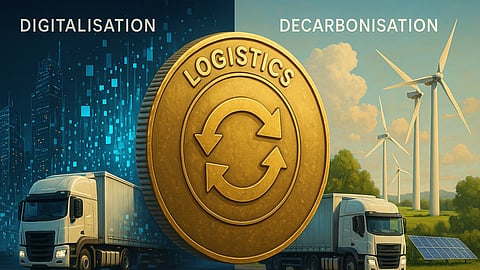Digitalisation and Decarbonisation: Two Sides of the Same Coin?
The logistics industry is at a crossroads. Two major forces, digitalisation and decarbonisation, are reshaping how goods move around the world. Each is transformative on its own, but together they have the power to make logistics operations smarter, cleaner, and more resilient.
As global trade expands, logistics providers face the dual challenge of improving efficiency while cutting carbon emissions. The question is not whether these two trends can align, but how quickly businesses can integrate them to stay competitive and compliant.
The Digital Backbone of Modern Logistics
Digitalisation in logistics is more than automation or software upgrades. It’s about connecting the entire value chain through data - from ports and warehouses to fleets and delivery points. Technologies like Internet of Things (IoT) sensors, predictive analytics, artificial intelligence (AI), and digital twins enable real-time monitoring of assets and routes.
This interconnectedness gives logistics operators the visibility and agility they need to make data-driven decisions that directly reduce emissions.
When these technologies are applied with sustainability in mind, the results are striking. IoT sensors and telematics give fleet managers detailed insights into vehicle performance, helping them avoid fuel waste and unnecessary maintenance.
From Paper Trails to Predictive AI: How Digitalisation is Rewiring Global Logistics
AI-powered route optimisation tools model traffic, weather, and load constraints to choose the most efficient — and lowest-carbon — routes. Digital freight matching platforms minimise empty miles, one of the biggest sources of avoidable emissions in road transport.
How Digitalisation Drives Decarbonisation
Digitalisation provides the tools, data, and control systems needed to meet decarbonisation targets in logistics. For example, digital freight exchanges allow carriers to share capacity and match loads efficiently, ensuring fewer trucks run empty.
Meanwhile, energy management software synchronises warehouse operations and fleet charging schedules with renewable energy availability, reducing dependency on fossil-fuel power.
Even back-office processes contribute to emissions reduction. Moving to paperless documentation - such as electronic Bills of Lading (eBLs) and blockchain-based tracking - eliminates the need for physical paperwork, speeds up customs clearance, and cuts down the emissions linked to printing and transport.
In short, digitalisation provides the intelligence layer that turns sustainability goals into measurable outcomes.
Barriers to Integration: The Challenges Ahead
Despite the potential, combining digitalisation and decarbonisation isn’t simple. Upfront costs remain a major hurdle, especially for smaller logistics firms. Implementing IoT, telematics, or AI systems requires investment and training, and the return on investment can take time to materialise.
Data fragmentation is another issue. Many ports, carriers, and warehouses use incompatible digital systems, limiting their ability to share emissions data across the supply chain. Without interoperability and standardisation, even the most advanced digital tools can’t reach their full sustainability potential.
There’s also the energy footprint of digitalisation itself. Data centres, cloud computing, and high-performance analytics consume electricity, which can offset carbon savings if powered by non-renewable energy sources. To avoid this rebound effect, logistics operators must ensure their digital infrastructure is energy-efficient and powered by clean energy.
Lastly, workforce transformation is crucial. As digital tools become central to logistics operations, employees must be trained to analyse data, manage smart systems, and act on sustainability insights. Without this cultural and skills shift, technology investments risk being underutilised.
The Future of Smart, Sustainable Logistics
Looking ahead to 2030 and beyond, the synergy between digitalisation and decarbonisation will define the next generation of logistics. Synchromodal transport networks will enable cargo to shift automatically between road, rail, or sea depending on cost, timing, and emissions data.
Autonomous electric or hydrogen vehicles will operate in controlled loops, optimised by AI to maintain ideal speeds and reduce energy waste.
Smart ports and distribution hubs will act as connected ecosystems, using sensors and analytics to minimise dwell times, manage power use, and coordinate supply chains in real time. Meanwhile, digital carbon accounting systems will make emissions tracking transparent and auditable, allowing shippers and customers to choose low-carbon logistics options with confidence.
As edge computing and lightweight AI reduce the power demand of digital systems, the environmental footprint of logistics technology itself will shrink. Together, these advances will create a logistics landscape where efficiency, visibility, and sustainability are inseparable.
Practical Steps for Logistics Firms
To move toward this digital-green future, logistics companies can start small but strategic. Pilot IoT-enabled route optimisation in a single corridor and measure both carbon and cost savings.
Adopt open standards and APIs to ensure interoperability with partners. Track and report the energy consumption of digital systems to ensure the benefits outweigh the footprint.
Embedding carbon reduction metrics into daily operations is also essential. Emissions performance should be tracked alongside delivery times and cost efficiency. Finally, invest in training and change management so that employees understand how digital tools contribute to sustainability outcomes.
A Digital Path to Net Zero
Digitalisation and decarbonisation are not parallel priorities - they are interdependent. In logistics, where emissions often stem from inefficiency, the insights and control enabled by digital tools make deep carbon reductions achievable. The companies that successfully integrate these strategies will lead the way toward net-zero logistics, combining operational excellence with environmental responsibility.
In the decade ahead, efficiency will no longer be measured by speed or cost alone, but by sustainability. And in that equation, digitalisation is the enabler - and decarbonisation the outcome. Together, they form the foundation of the logistics industry’s next great leap forward.
Read More: Jebel Ali Port Slashes Emissions By Expanding Electric Fleet 10X in 2025


